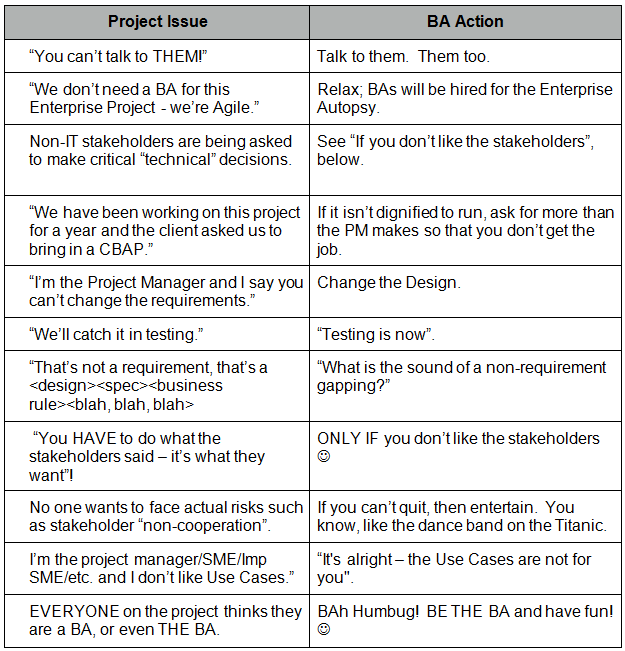Introduction
The role of the Business Analyst (BA) can be stressful, risky and thankless. BAs are change agents by profession. Change in work conditions tends to trigger fear: fear of job loss, of changing responsibilities and fear of the unknown are powerful motivators. Because of this, BAs attract resistance to change from political silos, rational (job loss) and irrational (change in work) fear from stakeholders, and irrelevant interference from dysfunctional egos. BAs are on the front lines of change, yet they are given little or no authority. If their work is misused, misunderstood or ignored for personal or political reasons, BAs may feel frustrated and appropriately concerned about project or regulatory failures. In the worst case, they may be benched, denied promotions, denied access to more interesting projects, be demoted or even fired.
One example (not widely publicized) involved a BA charged with doing the requirements for a system that would pay employees money they were owed for their work — money that had been withheld illegally, but then found by a government investigation. When asked to join the project, the BA suggested the solution would look a lot like a payroll system, especially since the government needed to withhold taxes from the wages paid. The BA was told, “We don’t do accounting systems,” by the project manager — “We do custom software.” The BA replied that a custom payroll system was certainly an option, at which point they were kicked out of the meeting and told they were not needed for the project. The BA was completely correct (the “custom software” project failed), but how could the BA have handled this situation for fun and profit?
The key to making business analysis more FUN and PROFITABLE is to understand that top BA practitioners are MORE than just problem solvers — they are also “people solvers.” It is not that top BAs feel differently from other BAs about their jobs. Top BAs DO something different from ordinary practitioners. They know that soft skills are used every single day, and that even slight improvements in what we do constantly yield big dividends.
This paper will provide motivation for building your BA soft skills. With luck, the material contained herein will help inspire you to reach for new levels of personal performance. If it does, you will improve your own life, your own career and the reputation of the BA profession. Enjoy!
The Inspiration of Excellence
If you are currently practicing as a BA, and like the work, you might have a goal to practice at even higher levels of responsibility, pay and project challenge. What is interesting is that senior-level business analysis can be practiced by persons of any. What is more, it can be learned at any age.
Consider the following finding, from IAG Consulting’s 2008 Research Report: Business Analyst Benchmark (http://www.iag.biz/):
“IAG investigated the connection between the competencies of the business analysis team and certain business outcomes expected by the business such as cutting costs, launching new products, regulatory compliance, reengineering the business, etc. The results demonstrate a remarkable difference between the performance of ‘average’ analysts and elite practitioners where process change is an expectation of the project. The elite analyst MUST be following a different process than the average analysts to create their success. There is no other explanation for the elite being successful in achieving objectives on 80% of projects, while in 60% of cases the average analyst fails to achieve the same objective.”
There is more to this quote than meets the eye. Even though “elite practitioners” are clearly following a different process, how are they able to get people to go along? This is the real difference between low- and high-level BAs — elite practitioners are able to guide and influence the processes they use due to their years of experience in the field. If you don’t believe this, imagine that an elite practitioner wrote up their process for you. Now you have the process, what is stopping you from total success? What is it like to “implement” a BA process in a “resistant” culture?
There is a temptation to believe that elite analysts were somehow “born” that way — that their current abilities have always been present. Some might think that what elite practitioners do is based on “emotional intelligence.” There is a tendency to believe that emotional intelligence is inborn, but consider the following quotation from Daniel Goleman, who first popularized the idea of emotional intelligence:
“Emotional competencies are job skills that can, and indeed must, be learned. An underlying EI ability is necessary, though not sufficient, to manifest competence…”
Goleman, Daniel, The Emotionally Intelligent Workplace. San Francisco: Josey-Bass, 2001. Print.
And this quote, attributed to Daniel Goleman, from the International Public Management Association for Human Resources on how emotional intelligence is developed:
“First, the ineffective behavior must be brought into awareness. Next, a new or more effective behavior must be identified and finally the new behavior must be consciously rehearsed over and over until it is mastered and becomes unconscious.”
IPMA-HR, Emotional Intelligence in the Public Sector, Western Region, May 3, 2006 (http://www.wripma-hr.org/Emotional_Intellegence.ppt)
Those who write and study the topic seem to agree: emotional intelligence can be learned, but this learning consists of changing our behavior. We don’t think our way into improving how stakeholders feel about us, we behave in new ways and the feelings follow.
Behavior change requires training and commitment. The training can show us choices for new behaviors, and the commitment will see us through trying them out.
The Inspiration to Highest Professional Standards
The International Institute of Business Analysis (IIBA can be found at www.theiiba.org) has established the definitive standards for the profession of business analysis. Among them is the Business Analysis Competency Model, which is based on the Business Analysis Book of Knowledge (BABOK, available free, along with the competency model, to IIBA members) and includes many soft skill-related “success” criteria. A few suggestive examples of what a BA does besides analysis include the following:
- Facilitates stakeholder consensus
- Regularly manages stakeholder expectations
- Collaborates effectively with Project Manager
- Effectively uses a variety of techniques to manage conflict
- Consistently receives feedback from stakeholders that satisfactory resolution (of any conflict) was reached
- Effectively formats and presents requirements in a manner appropriate to the stakeholder
- Effectively uses organizational networks/relationships to influence work outcomes and decisions
Each of these (and other similar ones such as those involving elicitation) gets ranked in terms of escalating performance. The highest level of performance is Mentoring, a soft skill in its own right. The IIBA has published a BA competency model that is setting the pace for BA performance evaluation. The self-assessment portion of the BA competency model (available at www.theiiba.org, under the “Professional Development” menu) describes this highest performance level as follows (each competency gets rated individually):
I consistently perform this competency (example: Manages Conflicts and Issues to Resolution and indicators based on knowledge and techniques in the BABOK Guide and I am looked to mentor others in this area.
No amount of analytical skill creates this competency — we all know the college Even getting your own mentor is easier if you have excellent soft skills.
As more employers embrace IIBA standards, the absence of soft skills will become increasingly unacceptable. Keep soft skills development high on your list. This is the best way to keep your job and your reputation, and to grow in your career.
The Inspiration of What Not To Do When You Have No Choice
Most BAs have seen how intelligence and technical skills are not enough to guarantee personal success. We have witnessed the “killing of the messenger” (the BA), and the “emperor with no clothes” (bad decision makers) and the “promotion of incompetence” (not the BA). Fact, knowledge and analysis are necessary for project success, but not sufficient in the face of personal and political agendas.
A classic case involves Roger Boisjoly, an engineer at NASA. He tried to stop the space shuttle launch that exploded in 1985, and had predicted the likelihood and cause of such a disaster (cold O-rings) over a year before it happened. His findings were ignored by decision makers, who cornered him into saying he had never tested rubber O-rings at the temperatures in question, and thus couldn’t know for sure what would happen during a launch. While we may respect Roger’s intellectual “honesty,” it did not pay off for him.
Similar examples contribute to approximately 66% of IT projects being challenged or failing outright. This widely cited finding first came from a Standish Group study in 1995 titled “Chaos,” and has changed very little as of 2009 (see following link: http://www1.standishgroup.com/newsroom/chaos_2009.php). Just like Boisjoly, the BA on a project often “knows” what will go wrong, and like Boisjoly, just knowing puts them in the line of fire. Whether the BA speaks up or not, they are involved with and share responsibility for the outcome.
At over 60%, the issue of project failure is even more common for BAs than for traditional engineers like Boisjoly. Many business project decision makers don’t recognize that business process change ALSO requires an engineer (the BA). Even when decision makers use BAs, they don’t always recognize that there is a special expertise in a BA that needs to be trusted and relied upon. Most of these same decision makers would certainly rely on a traditional engineer, whether designing their homes or diagnosing and repairing their cars. Such decision makers persist in expressing preferences and wishes instead of working closely with their BA “engineers” to understand the actual requirements for a successful outcome.
ONLY personal influence exhibited through soft skills has any chance of reaching such decision makers. Such influence is never guaranteed, while analysis seems much more certain. Ordinary BAs shy away from the “risk of influence.” Negotiation can seem intimidating or “unfriendly” to the novice, yet tough negotiating increases stakeholder satisfaction, which one might not know without doing the training. Sales and persuasion skills can evade BAs who pride themselves on straightforward communication without realizing that such skills are the essence of “tailoring to an audience.” BAs traditionally have little or no authority over others and mostly report to project managers. A BA might (reasonably) think that leadership skills are “out-of-scope,” and might even seem threatening to their boss.
Don’t do what ordinary BAs do. Don’t ignore the opportunities to add the influence of soft skills to your tool kit. You might even save a project “launch” from disaster.
The Inspiration of Stakeholder Satisfaction and BA Productivity
It is important to remember that soft skills determine how our stakeholders judge our performance. This is not merely a case of empty “image” or perception. Our soft skills actually make the biggest difference in our ability to elicit and build consensus around quality requirements. If we cannot handle “requirements nonsense” without giving offense, we lose momentum and influence with our stakeholders.
The following true story (all names and dates are changed or not revealed) illustrates the difference between “junior” and “senior” performance:
In 2007, a large government agency restarted a workflow automation project that had repeatedly failed for more than ten years. Every attempt to deliver a set of acceptable, feasible requirements had resulted in nothing. The most recent attempt had taken two years, and was contracted to a very large consulting firm. The only deliverable deemed acceptable was a “high level” requirements document, barely more than a vision, a few business requirements and a smattering of technical requirements.
The diagnosis was that the problem the project was trying to solve was extremely The stakeholders and the analysts were all overwhelmed by the complexity.
The solution was to narrow the scope and break it into more parts (good idea), and to elicit the requirements from stakeholders by using a GUI prototype. A new contractor was selected that had a junior BA with GUI prototyping skills.
Just before the project kicked off, the government insisted that a Senior BA be hired, which was done. The junior BA was assigned to facilitate stakeholder meetings and create all the GUI prototypes (bad idea), and the Senior BA (being the outsider on the team) was instructed to capture notes from the meetings and to produce the final deliverable requirements document.
At the stakeholder GUI sessions, misunderstandings between the facilitator and the stakeholders ensued. Because of the confusion, the stakeholders would insist on GUI changes one week, then insist on reverting to the prior version the very next week.
This went on for weeks without resolution. The Senior BA continued to prepare the requirements for delivery and review with stakeholders, confident that correct requirements were apparent in spite of the debates, and that these could be analyzed and presented in a clear way, eliminating confusion.
When the time came to present a “to-be” requirements model, the Senior BA was ready. After weeks of unending debate, the Senior BA presented the requirements as they were understood, without using GUIs. The nature of the stakeholder discussion changed. Suddenly, the stakeholders were excited to update the requirements and to hold the next review. While there were still disagreements, these were now focused on larger, more important issues.
What was the difference? How was trust lost by the junior BA, and how could they have gotten it back? What role could improved listening skills have played in helping the junior BA get past the misunderstanding? Would the junior BA alone have been able to complete the requirements, given the confusion and focus on “small” issues? The Senior BA did nothing directly to resolve the issues — how did they know the issues would resolve so quickly? How did the Senior BA know to take this approach instead of trying to intervene in the facilitation (intervention was not welcomed by the existing team)?
This last question is especially relevant, as the Senior BA in question had NOT always handled such matters well. The struggles of the junior BA were familiar to the Senior BA. The short answer to the question, according to the Senior BA in question, is experience, but experience is useless unless we change our behavior. The longer answer to the question involves a mix of commitment to personal growth combined with training and on-the-job practice (including a willingness to take risks, try new things and make embarrassing mistakes).
In this Senior BA’s own words, “I couldn’t think my way into behaving differently, I had to learn to behave differently so my thinking could change. Training exposed me to new behaviors, and my commitment to grow motivated me to try them on the job.”
The Inspiration of Job and Career Choices Expanded
Those who practice BA have an astonishing number of career choices, especially if they combine their knowledge and intelligence with the “people” techniques that juice job performance. Here are just a few examples of opportunities open to BAs with soft skills:
- In an increasingly global economy, the ability to be effective across cultures and phone lines is increasingly a guarantee of employment opportunity.
- Product Management including marketing issues
- Project Management
- PMO or BA Center of Excellence leadership
- Organization Change Manager
- CIO, COO, CEO
- Entrepreneur
- Management Consultant
- Professional Trainer
- Public Speaker, Author, Industry Expert
- IT Acquisitions Manager
- More (what’s on your list?)
Remember that interviewing for a job, acquiring a mentor, negotiating for raises and promotions, and selling yourself are soft-skills based. What you learn for the job will carry your career forward in ways you may not even anticipate.
The Inspiration of Going Beyond Survival to Joy and Fun
Those of us who have been on really fun projects all know there was a leader, or leaders, who really set the tone. When there is a person who can create trust, participation, buy-in and excitement, the outcome tends to be more complete discovery of requirements and more successful implementations.
Is there any better job than making things better, laughing all the way? If you won’t do it, who will? By learning how to handle and reduce tension in a group, how to “language” your elicitation, and how to set expectations properly, you can create an environment that is more relaxed, cooperative, and exciting and fun for the participants.
The Inspiration of Improving the Small Things We Do Every Day
How many times a day do you greet co-workers? Stakeholders? How often do you get the chance to build relationships, but feel constrained by time, or office convention, or some kind of unpleasant “history”?
Day-to-day life in any job can seem like being a sink with little tiny “personal holes” in it. We try to fill them, but cannot do so simply because we “know” them. These holes continually drain our time, resources and even our mental health. There can be so many holes that it seems pointless or overwhelming to worry about any tiny one of them. In a BA-type project, we MUST spend most of our time plugging the “technical holes.” It can be incredibly frustrating as we plug technical hole after hole, only to have leaky stakeholder holes pull the plug on our best moves.
Here is a story that shows the trap, and that we can get out anytime.
There was a man who never had enough money. No matter how hard he tried, he was always short $100 for his expenses. One day when he was complaining to a friend about his predicament, the friend asked him, “Is it always $100 that you are short each month?” “Yes”, replied the man, “give or take $20,” he continued. “You are very consistent, and have maintained yourself in spite of this difficulty?” asked the friend. “Oh, yes, I am a survivor,” exclaimed the man. “I work very hard every day to stay as close as I can.”
The friend continued: “Can you change one thing?” “Maybe,” said the man. “I want you to empty your pocket at the end of each day and put your spare change in a bucket — a bucket that you promise not to spend,” said the friend. The man thought, and then objected, “But that will be less than one dollar a day, less than $30 a month. How will that fix my problem?” The friend finished by saying, “If it doesn’t, let me know what happened. Worst case is that you spend the $30, no loss, no foul, no shame.”
A year later, the friends saw each other again. The man reported that he was now saving over $200 per month, and was getting out of debt. “What happened?” asked the friend. The man hesitated for a moment, then shared: “The first day I had 27 cents, and I gave it to myself. The second day I had 53 cents. Once I got used to giving myself spare change, I started tossing in an extra dollar or two, and pretty soon I was getting ahead. I was surprised at how it went. How did you know it would work for me?” “I didn’t,” said the friend, then continued, “I’m just glad it worked for you, but it was you that made things change. Congratulations.”
As BAs, we are change agents. We can see how good change is for our stakeholders, but (humanly) don’t see it as clearly for ourselves. Don’t be surprised if small change, even if it isn’t scary enough to “fix your problem,” adds up, and faster than you think. Your stakeholders need you to be sharp — don’t shortchange yourself. Give yourself an extra dollar; plug a hole; sharpen another tooth. Spend time on developing yourself, overflow the sink, fell the forest and watch the investment add up every day.
The Inspiration of a Better Life
The techniques that we can learn to be better BAs have an important side effect. They tend to make us better people. How could better listening improve your relationships or your job interviews? How can leadership and influence affect your family, friends and community? If you are able to get honest discussion of stakeholder issues and keep things positive in spite of conflict, how can this help you with those you love?
As you learn to clarify, communicate, negotiate and resolve tough issues with stakeholders, you will also learn to negotiate tough issues around raises and promotions, home improvement contracts, vacations, cars — almost everything is some kind of negotiation, whether you are participating or not.
The benefits run even deeper. Increased job performance will reduce stress overall. Confidence at work makes you more attractive to your spouse or prospective mates. The more you feel better, the more those around you feel better. What would it be like to embrace every personal encounter with ease, humor and calm?
Conclusion
We have acknowledged the special stresses of being a change agent in the BA role, and how these stem from “people issues.” We have looked at some examples of what it takes to be an excellent BA, and the importance of soft skills in achieving successful outcomes. We have discussed the many personal and professional benefits that can come from improving our soft skills. If we are looking for reasons to improve, we have seen plenty, but reason may not be enough for us, just as it is not always enough for our stakeholders.
We can think of reasons NOT to get soft skills training. It may involve embarrassing role-playing or seemingly trivial exercises. We may think that even if we try to change, our stakeholders and our organization will not let us. Nothing will move us to change more than inspiration and personal motivation, and these come from more than reason — they come from the heart.
Do you believe that you can lead? Are you moved by the possibility of doing more good with what you know? Does your love for your family and friends lead you to consider soft skills as more than “work”? We can be more effective BAs and happier human beings if we dare to grow. Take the risk of changing your behavior. Even small changes can start to pay big dividends. Start investing in your soft skills learning today!
Don’t forget to leave your comments below.
 Decision-making errors exist within all levels of organizations. Some common examples include:
Decision-making errors exist within all levels of organizations. Some common examples include:

 Disclaimer: Please note the following article contains strong language that some may find offensive but the message is one I feel is far too important to not relay. The following article was published in
Disclaimer: Please note the following article contains strong language that some may find offensive but the message is one I feel is far too important to not relay. The following article was published in 